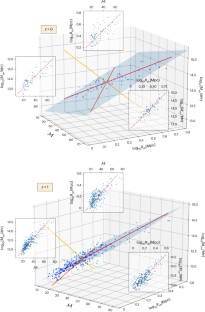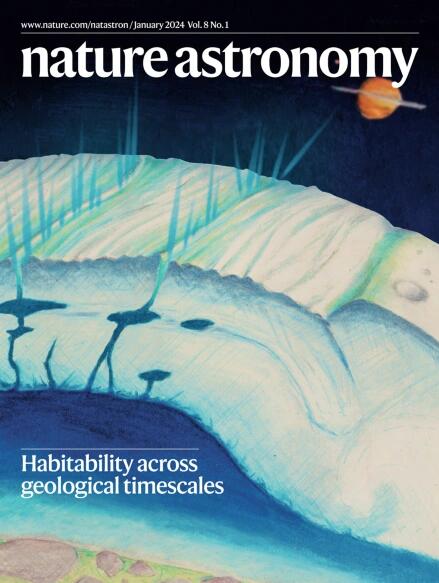以宇宙吸积冲击为工具测量星系团的暗物质质量
IF 12.9
1区 物理与天体物理
Q1 ASTRONOMY & ASTROPHYSICS
引用次数: 0
摘要
星系团形成过程中产生的宇宙吸积冲击是宇宙中无处不在的现象。这些冲击及其特征与星系团形成过程中的引力能量密切相关。通过对模拟星系团及其相关的吸积冲击样本的研究,我们发现样本中的天体位于星系团总质量、冲击半径和马赫数(冲击强度的量度)三维空间中的一个平面上。利用这一关系,并考虑到即将进行的新观测将能够测量冲击半径和强度,我们提出了一个想法,即可以间接测量星系团的暗物质含量,在1σ置信水平下误差可达30%左右。这个过程将是测量宇宙结构中暗物质质量的一种新的独立方法,也是对公认的Lambda冷暗物质范式的一种新的约束。本文章由计算机程序翻译,如有差异,请以英文原文为准。


Cosmic accretion shocks as a tool to measure the dark matter mass of galaxy clusters
Cosmological accretion shocks created during the formation of galaxy clusters are a ubiquitous phenomenon all around the universe. These shocks and their features are intimately related with the gravitational energy at stake during galaxy cluster formation. Studying a sample of simulated galaxy clusters and their associated accretion shocks, we show that objects in our sample sit in a plane within the three-dimensional space of cluster total mass, shock radius and Mach number (a measure of shock intensity). Using this relation, and considering that forthcoming new observations will be able to measure shock radii and intensities, we put forward the idea that the dark matter content of galaxy clusters could be indirectly measured with an error up to around 30% at the 1σ confidence level. This procedure would be a new and independent method to measure the dark matter mass in cosmic structures and a novel constraint to the accepted Lambda cold dark matter paradigm. A new scaling relation between cluster mass and the size and intensity of accretion shock waves could be used to indirectly measure the dark matter mass in galaxy clusters.
求助全文
通过发布文献求助,成功后即可免费获取论文全文。
去求助
来源期刊

Nature Astronomy
Physics and Astronomy-Astronomy and Astrophysics
CiteScore
19.50
自引率
2.80%
发文量
252
期刊介绍:
Nature Astronomy, the oldest science, has played a significant role in the history of Nature. Throughout the years, pioneering discoveries such as the first quasar, exoplanet, and understanding of spiral nebulae have been reported in the journal. With the introduction of Nature Astronomy, the field now receives expanded coverage, welcoming research in astronomy, astrophysics, and planetary science. The primary objective is to encourage closer collaboration among researchers in these related areas.
Similar to other journals under the Nature brand, Nature Astronomy boasts a devoted team of professional editors, ensuring fairness and rigorous peer-review processes. The journal maintains high standards in copy-editing and production, ensuring timely publication and editorial independence.
In addition to original research, Nature Astronomy publishes a wide range of content, including Comments, Reviews, News and Views, Features, and Correspondence. This diverse collection covers various disciplines within astronomy and includes contributions from a diverse range of voices.
 求助内容:
求助内容: 应助结果提醒方式:
应助结果提醒方式:


